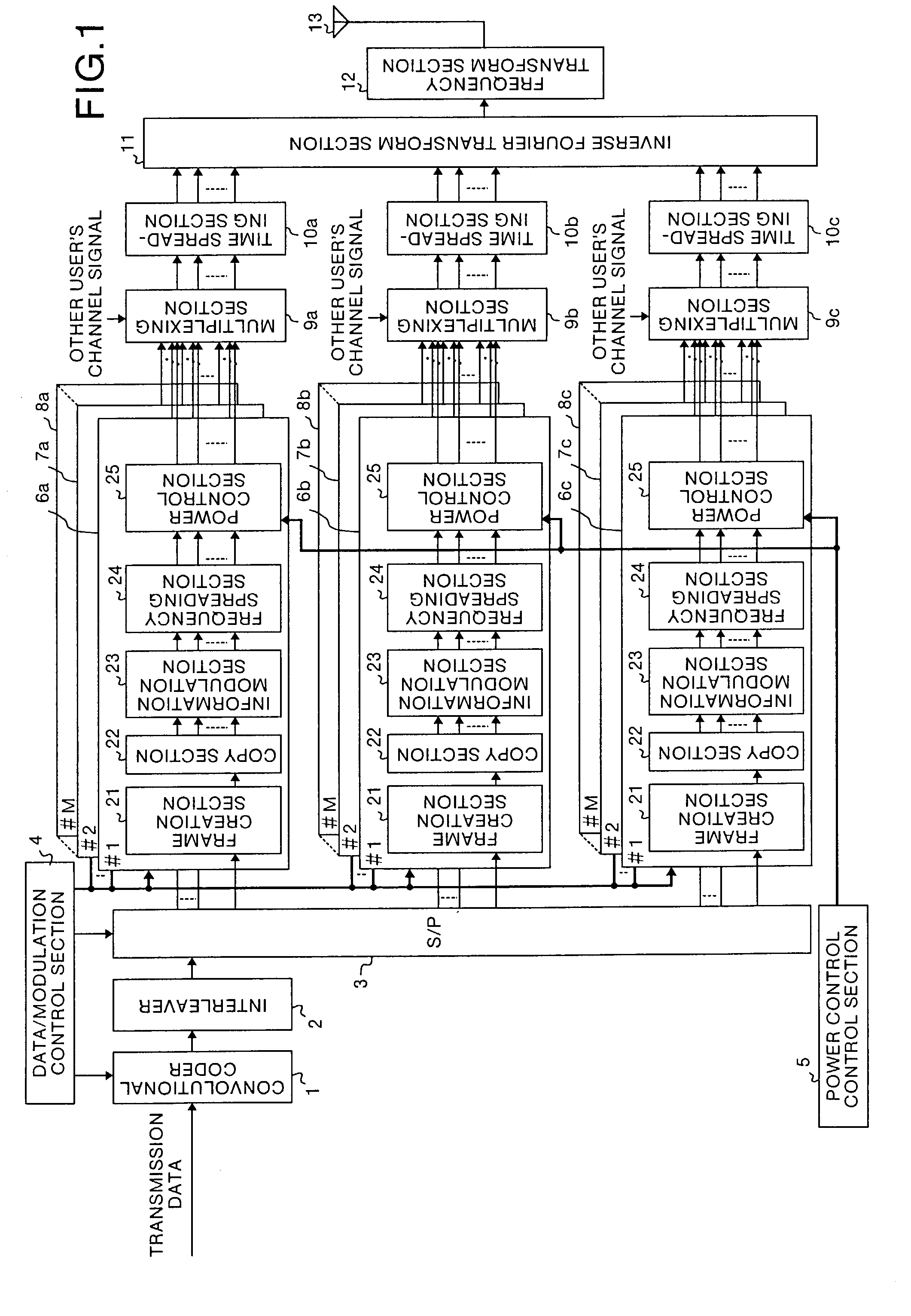Multi-carrier CDMA communication device, multi-carrier CDMA transmitting device, and multi-carrier CDMA receiving device
- Summary
- Abstract
- Description
- Claims
- Application Information
AI Technical Summary
Benefits of technology
Problems solved by technology
Method used
Image
Examples
first embodiment
[0101]FIG. 1 and FIG. 2 are diagrams which show the construction of a multi-carrier CDMA communication apparatus of the present invention in the first embodiment. FIG. 1 is a diagram which shows the construction of a multi-carrier CDMA transmitter and FIG. 2 is a diagram which shows the construction of a multi-carrier CDMA receiver in this embodiment.
[0102]In FIG. 1, reference symbol 1 denotes a convolutional coder, 2 denotes an interleaver, 3 denotes a serial / parallel conversion section (hereinafter, referred to as S / P), 4 denotes a data / modulation control section, 5 denotes a power control control section, 6a, 6b, 6c, 7a, 7b, 7c, . . . , 8a, 8b and 8c denote first, second, and Nscg-th sub-carrier group modulation processing sections provided for each channel, 9a, 9b and 9c denote multiplexing sections, 10a, 10b and 10c denote time spreading sections, 11 denotes an inverse Fourier transform section, 12 denotes a frequency transform section, 13 denotes an antenna, 21 denotes a frame...
second embodiment
[0148]A multi-carrier CDMA communication apparatus in the second embodiment has the same construction as that in the first embodiment, with the exception that the relation between the sub-carrier and the frequency spreading code arranged on the frequency axis is different. Only the portion different from that of the first embodiment will be explained herein.
[0149]FIG. 22 is a diagram which shows the relation between a sub-carrier and a frequency spreading code group allocated for each sub-carrier. In this second embodiment, differing from the first embodiment, the frequency spreading code is allocated, with a certain frequency interval (sub-carrier interval), while keeping the orthogonality and hierarchical relationship between the frequency spreading codes. Sequence elements shown in FIG. 10 are periodically allocated, while keeping the orthogonality and hierarchical relationship between the frequency spreading codes shown in FIG. 9.
[0150]Thus, in the second embodiment, the same ef...
third embodiment
[0152]A multi-carrier CDMA communication apparatus in the third embodiment has the same construction as that of the first embodiment, with the exception that the internal construction and the operation of the synchronization detector 55, the combining section 56 and the path combining section 57 of the receiver are different. Only the portion different from that of the first embodiment will be explained herein.
[0153]FIG. 23 is a diagram which shows the construction of the synchronization detector 55 in the third embodiment. In FIG. 23, reference symbols 191, 194 and 197 denote transmission line estimation sections, 192, 195 and 198 denote complex conjugate calculation sections, and 193, 196 and 199 denote multipliers. The synchronization detector 55 receives sub-carrier signals (1, 1) to (1, Nsub) after the inverse spreading, and performs synchronization detection, using the known sequence added for each slot in the frame. The synchronization detector 55 outputs the sub-carrier sign...
PUM
 Login to view more
Login to view more Abstract
Description
Claims
Application Information
 Login to view more
Login to view more - R&D Engineer
- R&D Manager
- IP Professional
- Industry Leading Data Capabilities
- Powerful AI technology
- Patent DNA Extraction
Browse by: Latest US Patents, China's latest patents, Technical Efficacy Thesaurus, Application Domain, Technology Topic.
© 2024 PatSnap. All rights reserved.Legal|Privacy policy|Modern Slavery Act Transparency Statement|Sitemap



